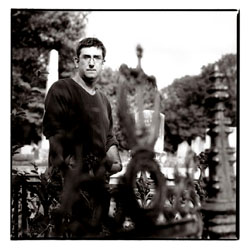|
The
Final Frontier
This
much we know: the end is the same for each of us.
“All
the talk of death being a taboo is just symptomatic of how obsessed
we are with it,” says Associate Professor of American Religious
History and Culture Gary Laderman, “All human cultures
are preoccupied with death.”
Laderman–who
helped to organize April’s conference on health, healing,
and spirituality–was glad to have a respite from his primary
area of expertise: the rituals of death and dying.
 Death
certainly permeates American popular culture, through movies
like M. Night Shyamalan’s The Sixth Sense, hit shows
such as the HBO series Six Feet Under, nihilistic heavy
metal music, and Alice Sebold’s best-selling novel The
Lovely Bones, written from the perspective of a murdered
girl. Death
certainly permeates American popular culture, through movies
like M. Night Shyamalan’s The Sixth Sense, hit shows
such as the HBO series Six Feet Under, nihilistic heavy
metal music, and Alice Sebold’s best-selling novel The
Lovely Bones, written from the perspective of a murdered
girl.
As
mortal beings aware of the temporal nature of our lives, we
keep death close, says Laderman, who wears a skull ring as a
personal reminder.
His
just-released book, Rest in Peace, gives a cultural history
of death and the funeral home in twentieth-century America.
From the evolution of embalming (a practice that took off after
President Lincoln’s assassination) to the increasing popularity
of customized memorial services, Laderman tracks the manner
in which we care for and dispose of our dead.
“In
the end, the dead come back to life in American society. Indeed,
American society comes to life thanks to the luminous presence
of the dead in the imaginative and physical landscapes of its
citizens. . . . It is more like a cult of the dead than a symptom
of a culture in denial.”
–Associate
Professor Gary Laderman in Rest in Peace.
Baby
boomers have embraced efficiency and economy: more funerals
are pre-planned to cut down on expenses and there has been a
sharp increase in cremation over the past two decades. Forty
years ago, fewer than 4 percent of Americans chose cremation;
in 1995, 21 percent did; and by 2010, it is projected that 40
percent will.
Cremains
may be incorporated into a commemorative fireworks display,
launched into space (á la Gene Roddenberry and
Timothy Leary), or simply placed in an urn.
And
with a new spectrum of computer-assisted options–virtual
funerals via Web-casting, e-testimonials about the departed,
and internet viewing of cremations–technology is taking
memorial services full force into the future. “Cyberspace
offers another arena in which to enact rituals . . . with a
click of a button,” he says.
There
is also an increasing desire to craft the details of the funeral
to reflect the personality of the deceased, and a corresponding
willingness on the part of the funeral industry to be open to
new requests.
“Since
the 1960s, the rigidity of funeral traditions has been breaking
down,” Laderman says. “Baby Boomers are facing the
final frontier and they are insisting upon individual choices
and religious freedom.”
Reports of the demise of large ceremonies at funeral homes,
open caskets, or chemical embalming, however, may prove premature.
Family and friends, says Laderman, do want the chance to say
goodbye.
“Funeral
directors are very clear about the value and popularity of a
last look at the deceased . . .this crucial, short-lived window
of opportunity for the living to be with their dead,” he
writes. “A brief, intimate moment–looking at their
face, touching the casket, being in the presence of the corpse
for a short time–is an ingrained ritual gesture that brings
meaningful, and material, order out of the chaos of death.“–M.J.L.
|